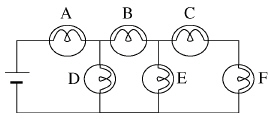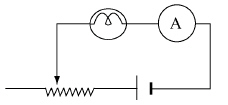Multiple Choice
Identify the
choice that best completes the statement or answers the question.
|
|
|
1.
|
A __________ is described as a device with specific resistance and is used to
control current.
a. | series connection | c. | resistor | b. | parallel connection | d. | battery |
|
|
|
2.
|
A lamp draws a current of 0.50 A when it is connected to a 120 V source?
What is the resistance of the lamp?
a. | 4.17  10-2 ohms 10-2 ohms | c. | 2.4  102
ohms 102
ohms | b. | 24  102 ohms 102 ohms | d. | 60 ohms |
|
|
|
3.
|
A/An _____ is described as a closed loop or pathway that allows electric charges
to flow, whereas a/an _____ is described as a flow of charged particles.
a. | conventional current, electric current | c. | conventional current, electric
circuit | b. | electric circuit, electric current | d. | electric current, electric
circuit |
|
|
|
4.
|
The flow of electric charge or current equal to one coulomb per second is a/an
_____.
a. | ampere | c. | volt | b. | kilowatt hour | d. | ohm |
|
|
|
5.
|
Which of the following circuits can be used to test whether or not a wire of a
laminated heating element is cut internally?
|
|
|
6.
|
In the circuit shown below, which bulb, when burned out, will cause all other
bulbs to stop glowing? 
|
|
|
7.
|
A motor with an operating resistance of 32 ohms is connected to a voltage
source. The current in the circuit is 3.8 A. What is the voltage of the source?
a. | 1,216 V | c. | .12 V | b. | 8.42 V | d. | 1.2  102
V 102
V |
|
|
|
8.
|
A/An _____ is described as the flow of positive charges that move from a higher
to lower potential energy.
a. | conventional current | c. | conventional circuit | b. | electric circuit | d. | electron flow |
|
|
|
9.
|
A/An _____ is the flow of positive charges that move from higher to lower
potential energy, whereas a/an _____ is described as a flow of charged particles.
a. | conventional current, electric current | c. | conventional current, electric
circuit | b. | electric circuit, conventional current | d. | electric current, conventional
current |
|
|
|
10.
|
A lightbulb uses 75 W of power when it is connected across a 125 V source. What
current does the lamp draw?
a. | 1.67 A | c. | 0.60 A | b. | 9.375 A | d. | 9.38 A |
|
|
|
11.
|
A _____ is described as a device that converts chemical energy to electric
energy.
a. | capacitor | c. | resistor | b. | lightbulb | d. | battery |
|
|
|
12.
|
_____ is described as a property that determines how much current will flow for
a given battery voltage.
a. | Resistance | c. | Kilowatt-hour | b. | Resistor | d. | Thermal energy |
|
|
|
13.
|
A sensor uses 2.0  10 -4 A of current when it is operated by a
3.0 V battery. What is the resistance of the sensor circuit? a. | 1.5  104 ohms 104 ohms | c. | 6.0  10-4
ohms 10-4
ohms | b. | 6.7  10-5 ohms 10-5 ohms | d. | 6.9  104
ohms 104
ohms |
|
|
|
14.
|
A/An _____ is a type of electric circuit in which there are multiple paths,
whereas a/an _____ is a type of electric circuit in which there is a single current path.
a. | series connection, parallel connection | c. | conductor,
insulator | b. | insulator, conductor | d. | parallel connection, series connection |
|
|
|
15.
|
_____ is a property that determines how much current will flow for a given
source voltage, whereas a _____ is a device that controls the current in a circuit.
a. | Battery, resistance | c. | Resistance, resistor | b. | Resistance, battery | d. | Resistor,
resistance |
|
|
|
16.
|
In the circuit shown below, the ammeter shows that there is a current. However,
the bulb does not light because:  a. | the variable resistance has a large value | b. | the wire between the
cell and the bulb is broken | c. | the battery terminal is
loose | d. | the bulb is burned out |
|
|
|
17.
|
A car panel lamp has a resistance of 33 ohms when it is placed across a 12 V
battery. What is the current through the circuit?
a. | 3.96 A | c. | .36 A | b. | 2.8 A | d. | 396 A |
|
|
|
18.
|
A/An _____ is described as the flow of charged particles.
a. | electric current | c. | electric potential difference | b. | gravitational
force | d. | electric
field |
|
|
|
19.
|
A lamp uses 15 W of power when it is connected across 25 V. What is the
current through the lamp?
a. | 93.8  103 A 103 A | c. | 0.60 A | b. | 9.38  103 A
103 A | d. | 1.67
A |
|
|
|
20.
|
A/An _____ is a type of electric circuit in which there is a single current
path.
a. | parallel connection | c. | series connection | b. | conventional current | d. | electric
current |
|
|
|
21.
|
A lightbulb uses 100 W of power when connected across 120 V. What is the
current drawn by the lightbulb?
a. | 12. A | c. | 1.0 A | b. | 2.0 A | d. | 0.8 A |
|
|
|
22.
|
A _____ is described as a device with specific resistance and is used to control
current, whereas a _____ converts chemical energy to electrical energy.
a. | battery, resistor | c. | resistor, battery | b. | insulator, resistor | d. | conductor,
battery |
|
|
|
23.
|
A flashlight bulb is rated at 0.90 W. If the electric potential drop
across the lightbulb is 3.0 V, how much current goes through it?
a. | 0.30 A | c. | 2.7 A | b. | 3.33 A | d. | 3.0 A |
|
|
|
24.
|
A/An _____ is described as the flow of electric charge or current equal to one
coulomb per second.
a. | capacitance | c. | capacitor | b. | volt | d. | ampere |
|
|
|
25.
|
A/An _____ is described as a flow of charged particles.
a. | electric current | c. | resistor | b. | resistance | d. | electric
circuit |
|
|
|
26.
|
What is the effect on the current in a simple circuit when both the voltage and
the resistance are divided by 2?
a. | multiplied by 4 | c. | divided by 2 | b. | multiplied by 2 | d. | no change |
|
|
|
27.
|
Which of the following circuits can be used to measure the resistance of the
heating element, shown as a resistor in the diagrams below?
|
|
|
28.
|
A/An _____ is described as a closed loop or pathway that allows electric charges
to flow.
a. | conventional current | c. | electric circuit | b. | series connection | d. | parallel
connection |
|
|
|
29.
|
A car battery causes a current of 2.0 A through a lamp and produces 12 V across
it. What is the power used by the lamp?
a. | 6 W | c. | 0.167 W | b. | 24 W | d. | 48 W |
|
Matching (Value 8)
|
|
|
Define the following terms by matching them with the correct
definition. a. | electric current | e. | resistance | b. | conventional
current | f. | resistor | c. | battery | g. | ampere | d. | electric
circuit | h. | kilowatt-hour |
|
|
|
30.
|
a device that converts chemical energy to electric energy
|
|
|
31.
|
a property that determines how much current will flow
|
|
|
32.
|
a flow of charged particles
|
|
|
33.
|
the flow of positive charges that move from higher to lower potential
energy
|
|
|
34.
|
a device with specific resistance; used to control current in circuits
|
|
|
35.
|
an energy unit used by electric companies to measure energy use
|
|
|
36.
|
a closed loop or pathway that allows electric charges to flow
|
|
|
37.
|
the flow of electric charge or current equal to one coulomb per second
|
Short Answer
|
|
|
38.
|
Draw a circuit diagram showing a 2-V battery connected in series to an ammeter,
a 5-W resistor, and a switch.
|
|
|
39.
|
Define resistance in terms of voltage and current without using an
equation.
|
|
|
40.
|
What is electric power in terms of current and voltage?
|
|
|
41.
|
A platinum wire and a gold wire have the same length and cross-sectional area.
Do they have the same resistance?
|
Problem
|
|
|
42.
|
A battery of potential difference 24 V delivers  J to a conductor. What
is the quantity of charge that flows through the conductor?
|
|
|
43.
|
A 2.0-V battery is connected in a circuit with an ammeter and an unknown
resistor, P. The current is observed to be 0.70 A. What would be the current in the circuit if a 12-V
battery replaces the 2.0-V battery?
|
|
|
44.
|
There is a 0.40-A current in resistor X when it is connected to a 2.0-V battery.
A 0.25-A current is in a second resistor, Y, when it is connected to a 4-V battery. There is a 0.50-A
current in a third resistor, Z, when it is connected to a 5.0-V battery. Find the resistor that has
the maximum resistance and the resistor that has the least resistance.
|
True/False (Value 10)
Indicate
whether the statement is true or false.
|
|
|
45.
|
An electric current is a flow of charged particles.
|
|
|
46.
|
The flow of electric charge or current that is equal to one coulomb per second
is an ampere.
|
|
|
47.
|
Resistance is a property that determines how much current will flow in a
circuit.
|
|
|
48.
|
A resistor is a device that converts chemical energy into electric
energy.
|
|
|
49.
|
A conventional current is the flow of positive charges that move from a higher
to lower potential energy.
|
|
|
50.
|
An electric circuit is a closed loop or pathway that allows electric charges to
flow.
|
|
|
51.
|
A parallel connection is a type of electric circuit in which there is a single
current path.
|
|
|
52.
|
A resistor is a device that controls current in electric circuits.
|
|
|
53.
|
Using a 1-kW heater for one hour consumes more energy than using a 100-W bulb
for one day.
|
|
|
54.
|
A series connection is a type of electric circuit in which there are multiple
paths.
|